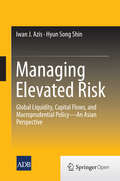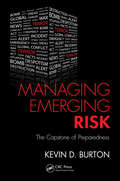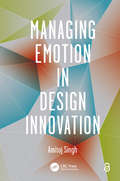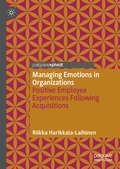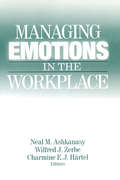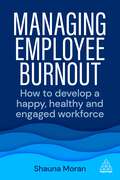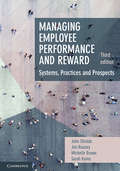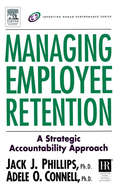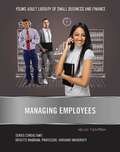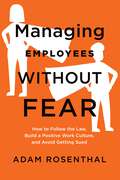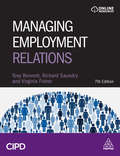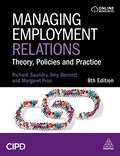- Table View
- List View
Managing Educational Tourism
by Brent W. RitchieIncreasingly tourists are seeking learning and educational holidays. This interest has led to the provision of tourism product with some form of learning or education as an integral component, including cultural heritage tourism and ecotourism. The growth of offshore education and lifelong learning has stimulated cross-border movement for language learning, school excursions and university student travel. Reflecting this growth in educational tourism types, the author outlines the main forms of educational tourism, their demand and supply characteristics, their impacts and the management issues associated with them, taking a holistic systems-based perspective. The book argues that without adequate research and appropriate management of educational forms of tourism, the potential regional development impacts and personal learning benefits will not be maximised. The book highlights the need for collaboration and networking between both the tourism and education industries to adequately manage the issues surrounding the growth in educational tourism.
Managing Electronic Records
by Robert F. Smallwood Robert F. WilliamsThe ultimate guide to electronic records management, featuring a collaboration of expert practitioners including over 400 cited references documenting today's global trends, standards, and best practicesNearly all business records created today are electronic, and are increasing in number at breathtaking rates, yet most organizations do not have the policies and technologies in place to effectively organize, search, protect, preserve, and produce these records. Authored by an internationally recognized expert on e-records in collaboration with leading subject matter experts worldwide, this authoritative text addresses the widest range of in-depth e-records topics available in a single volume.Using guidance from information governance (IG) principles, the book covers methods and best practices for everything from new e-records inventorying techniques and retention schedule development, to taxonomy design, business process improvement, managing vital records, and long term digital preservation. It goes further to include international standards and metadata considerations and then on to proven project planning, system procurement, and implementation methodologies. Managing Electronic Records is filled with current, critical information on e-records management methods, emerging best practices, and key technologies.Thoroughly introduces the fundamentals of electronic records managementExplains the use of ARMA's Generally Accepted Recordkeeping Principles (GARP®)Distills e-records best practices for email, social media, and cloud computingReveals the latest techniques for e-records inventorying and retention schedulingCovers MS SharePoint governance planning for e-records including policy guidelinesDemonstrates how to optimally apply business process improvement techniquesMakes clear how to implement e-document security strategies and technologiesFully presents and discusses long term digital preservation strategies and standardsManaging e-records is a critical area, especially for those organizations faced with increasing regulatory compliance requirements, greater litigation demands, and tightened internal governance. Timely and relevant, Managing Electronic Records reveals step-by-step guidance for organizing, managing, protecting, and preserving electronic records.
Managing Elevated Risk
by Hyun Song Shin Iwan J. AzisThis book discusses the risks and opportunities that arise in Emerging Asia given the context of a new environment in global liquidity and capital flows. It elaborates on the need to ensure financial and overall economic stability in the region through improved financial regulation and other policy measures to minimize the emergent risks. "Managing Elevated Risk: Global Liquidity, Capital Flows, and Macroprudential Policy--An Asian Perspective" also explores the range of policy options that may be deployed to address the impact of global liquidity on domestic financial and socio-economic conditions including income inequality. The book is primarily aimed at policy makers, financial market regulators and supervisory agencies to help them improve national regulatory systems and to promote harmonization of national regulations and practices in line with global standards. Scholars and researchers will also gain important information and knowledge about the overall impacts of changing global liquidity from the book.
Managing Elite Sport Systems: Research and Practice (Routledge Research in Sport Business and Management)
by Barrie Houlihan Svein S. Andersen Lars Tore RonglanOver the last twenty years or so there has been a sharp increase in interest from national sports federations and governments in the development of effective elite sport systems, particularly focused on achieving success in the summer and winter Olympic Games. Many countries now have publicly funded elite sports strategies which provide specialist facilities and support staff and often provide direct financial support for athletes. These developments have stimulated academic interest in describing the elite sport systems, analysing the processes by which policy is established and evaluating the impact of these policies on elite athlete success. Far less attention has been placed on the operation of the elite sports systems and on how the system interfaces with the athlete. The aim of this book is to refocus attention on the management and operation of systems designed to deliver elite success. The book draws on the theoretical literature in implementation, organisation theory, leadership and complexity. This provides an initial context for analysis and a stimulus for theory development around key questions such as: How do coaches manage their relationship with athletes? How does talent identification operate in practice? Do coaches fulfil the role of gatekeeper between the athlete and other elements of the sports system e.g. sports science support? How do managers, support staff and athletes interpret the expectations placed on them? The first part of the book focuses on aspects of the effectiveness of elite sports systems and the second explores aspects of systems operation focused on the interface between the athlete and the sport development system, and cross-cutting themes within the book include the management of talent identification and coach development. This is illuminating reading for any student, researcher or practitioner working in sport development, sport management or sports coaching.
Managing Emergencies and Crises: Global Perspectives
by Naim Kapucu Alpaslan Özerdem Abdul-Akeem SadiqAs the scale, frequency, and intensity of crises faced by the world have dramatically increased over the last decade, there is a critical need for a careful stocktaking on the knowledge of managing disasters. Managing Emergencies and Crises: Global Perspectives, Second Edition clearly and comprehensively explores the most important concepts of emergency and crisis management (such as mitigation, protection, prevention, preparedness, response, recovery, vulnerability and risk assessment) and illustrates them with cases involving disasters and emergencies worldwide. Substantially revised, the Second Edition has been reorganized and includes two new and timely chapters on terrorism and emergency management and public health emergencies and crises. It also provides an emphasis on management and leadership and cross-sector governance from interdisciplinary and global perspectives. Two new chapters: Terrorism and Emergency Management and Public Health Emergencies and Crises. Wide range of scholarly perspectives are presented to guide readers' understanding of various concepts in the emergency and crisis management field. Rich and diverse case studies illustrate how various stakeholders, including emergency program managers, respond in crisis and emergency management situation. Navigate eBook Access (included with the print text) provides online or offline access to the digital textbook. Upper level undergraduate and graduate level courses in Disaster Preparedness, Preparedness Training, Emergency Management Training (EMT), Preparedness and Emergency Response, Preparedness and Planning Also appropriate for researchers, practitioners and leaders involved in crisis response. © 2023 | 325 pages
Managing Emerging Data Technologies: Concepts and Use
by Duncan R. ShawEmerging data technologies are one of several forces that are changing the world. This textbook shows how technologies such as the Internet of Things, Artificial Intelligence and data analytics are altering business operations and strategy. Following a unique, three-part structure, the book offers: • a macro view of the environmental drivers which are changing organisations • a meso view of how organisations and business functions are responding • a micro view of the skills needed to take advantage of the new opportunities that these technologies bring A wide range of examples featuring well-known companies aid understanding, while practical activities help students to develop the skills they need in business. A downloadable teaching guide and PowerPoints are available for those using the book in their teaching. Managing Emerging Data Technologies: Concepts and Use is essential reading for upper-undergraduate and postgraduate students of courses related to new digital data technologies in business, as well as anyone looking to use these technologies in their organisation. Duncan R. Shaw teaches business strategy and data technology strategy at business schools around the world, including Alliance Manchester Business School in Hong Kong, and Nottingham University Business School in the UK and Malaysia.
Managing Emerging Data Technologies: Concepts and Use
by Duncan R. ShawEmerging data technologies are one of several forces that are changing the world. This textbook shows how technologies such as the Internet of Things, Artificial Intelligence and data analytics are altering business operations and strategy. Following a unique, three-part structure, the book offers: • a macro view of the environmental drivers which are changing organisations • a meso view of how organisations and business functions are responding • a micro view of the skills needed to take advantage of the new opportunities that these technologies bring A wide range of examples featuring well-known companies aid understanding, while practical activities help students to develop the skills they need in business. A downloadable teaching guide and PowerPoints are available for those using the book in their teaching. Managing Emerging Data Technologies: Concepts and Use is essential reading for upper-undergraduate and postgraduate students of courses related to new digital data technologies in business, as well as anyone looking to use these technologies in their organisation. Duncan R. Shaw teaches business strategy and data technology strategy at business schools around the world, including Alliance Manchester Business School in Hong Kong, and Nottingham University Business School in the UK and Malaysia.
Managing Emerging Risk: The Capstone of Preparedness
by Kevin D. BurtonFrom Main Street to Mumbai, Managing Emerging Risk: The Capstone of Preparedness considers the new global drivers behind threats and hazards facing all those tasked with protecting the public and private sector. The text delves into the global mindset of public and private sector emergency managers and presents a new risk landscape vastly different from the one existing ten years ago.The book begins by presenting a series of fictitious scenarios each resulting in mass destruction and fatalities. These are each followed by actual news stories that support the scenarios and demonstrate that the proposed events‘seemingly unthinkable have the potential to occur. Next, the author identifies two drivers in the practice of emergency management and general preparedness today that constitute our view of the future and the new face of risk. The first is the Disaster Halo Effectthe idea that modern threats exhibit more than one event. The second is the worldview of our nation as a Market State focused on the trading of goods, services, and ideas among the nation-states. The book also reviews the history of preparedness and discusses its relationship with large-scale threats, establishing that hindsight bias has hurt our ability to plan and respond to the unexpected.The chapters that follow explore what is needed to better cultivate, design, develop, and operate emerging management and preparedness thinking in the current environment. Each chapter begins with key terms and objectives and ends with thought-provoking questions. Introducing a new paradigm of thought that takes into account the chief influencers of global threats, the book arms emergency and business operations managers with the ammo needed to successfully confront emerging threats in the 21st century.
Managing Emotion in Design Innovation
by Amitoj SinghThis book presents an emotion centered research framework titled "emoha" for design innovation. It defines emoha and underlines the importance of the developed framework in culturalization of technology and thereby design innovation. The book explains the detailed research on product styling which leads to the creation of "Emoha" and how to use it in product design.
Managing Emotions in Organizations: Positive Employee Experiences Following Acquisitions
by Riikka Harikkala-LaihinenThis book takes a fresh perspective to acquisition research, focusing on employee emotions. It builds on the human-centric approach to mergers and acquisitions, where previous literature has concluded that emotions are important, yet few studies have explored them in depth. To fill the gap, this book takes emotion research in organizations as its starting point, exploring what emotions are, how they emerge, and how they influence organizational contexts, such as acquisitions. Whereas previous acquisition literature has concluded that emotions are most often negative and lead to complications, this book shows how emotions can become a positive force driving post-acquisition change and unification. This book combines multidisciplinary theoretical insights with practical real-world case studies to provide detailed analysis and approachable findings that will appeal to academics and practitioners alike.
Managing Emotions in the Workplace (Research On Emotion In Organizations Ser.)
by Neal M. Ashkanasy Wilfred J. Zerbe Charmine E. HartelThe modern workplace is often thought of as cold and rational, as no place for the experience and expression of emotions. Yet it is no more emotionless than any other aspect of life. Individuals bring their affective states and emotional "buttons" to work, leaders try to engender feelings of passion and enthusiasm for the organization and its mission, and consultants seek to increase job satisfaction, commitment, and trust. This book advances the understanding of the causes and effects of emotions at work and extends existing theories to consider implications for the management of emotions. The international cast of authors examines the practical issues raised when organizations are studied as places where emotions are aroused, suppressed, used, and avoided. This book also joins the debate on how organizations and individuals ought to manage emotions in the workplace. Managing Emotions in the Workplace is designed for use in graduate level courses in Organizational Behavior, Human Resource Management, or Organizational Development - any course in which the role of emotions in the workplace is a central concern. Scholars and consultants will also find this book to be an essential resource on the latest theory and practice in this emerging field.
Managing Employee Burnout: How to Develop A Happy, Healthy and Engaged Workforce
by Shauna MoranBurnout is a state of emotional, physical and mental exhaustion. In the workforce, it leads to higher levels of stress, greater sickness absence, sluggish productivity and increased staff turnover so addressing this is urgent.Managing Employee Burnout covers everything from what burnout is, what causes it and what different forms it can take. It also explores the role of the organization in employee burnout and includes specific guidance on how to manage burnout in remote and hybrid working environments and why dispersed teams may be more susceptible to burnout. Full of actionable advice and real world examples, this book demonstrates what strategies to put in place to safeguard staff retention and productivity from burnout as well as how to promote awareness and emotional intelligence in the business. This book also explains why effective company culture, communication, leadership and an inclusive talent strategy are key to building a healthy, engaged and sustainable workforce. There is also coverage of how to improve employees' mental health and discussion of the importance of taking a break and how to establish healthy boundaries. Managing Employee Burnout is crucial reading for all HR professionals and all those responsible for talent management who are looking to ensure a healthy, happy and productive workforce.
Managing Employee Performance and Reward
by Patrick O'Leary John Shields Michelle Brown John Shields Michelle Brown Sarah Kaine Catherine Dolle-Samuel Andrea North-Samardzic Peter McLean Robyn Johns Patrick O'Leary Geoff Plimmer Jack Robinson Sarah Kaine Catherine Dolle-Samuel Andrea North-Samardzic Peter Mclean Robyn Johns Geoff PlimmerNow in its second edition, Managing Employee Performance and Reward continues to offer comprehensive coverage of employee performance and reward, presenting the material in a conceptually integrated way. This new edition has been substantially updated and revised by a team of specialist contributors, and includes: • an increased focus on employee engagement and the alignment between the organisation's goals and the personal goals of employees • expanded coverage of coaching, now a leading-edge performance enhancement practice • extensive updates reflecting the major changes in employee benefits in recent years, as organisations strive to attract and retain talent • updated coverage of executive salaries and incentives in the contemporary post-GFC environment. This popular text is an indispensable resource for both students and managers alike. Written for a global readership, the book will continue to have particular appeal to those studying and practising people management in the Asia-Pacific region.
Managing Employee Performance and Reward: Concepts, Practices, Strategies
by John ShieldsManaging Employee Performance and Reward critically examines contemporary theory and practice in these central fields of human resource management (HRM), providing a comprehensive overview of the key concepts and topics, and draws on a wide range of case studies to demonstrate the theories. The book provides an analysis of the crucial literature on remuneration and performance management, exploring the main theories, debates and practices. The book seeks to provide students with a thorough understanding of the debates associated with issues of work motivation, pay equity, performance management ethics; the methods of pay and performance management; the systems of performance pay; and the options and issues facing managers. It encourages students to form a critical understanding of the debates it raises by providing an overview of the alternatives.
Managing Employee Performance and Reward: Systems, Practices and Prospects
by John Shields Michelle Brown Sarah Kaine Jim RooneyThe third edition of Managing Employee Performance and Reward: Systems, Practices and Prospects has been thoroughly revised and updated by a new four-member author team. The text introduces a new conceptual framework based on systems thinking and a dual model of strategic alignment and psychological engagement. Coverage of chapter topics provides a balance between research evidence and practice and, in this new edition, is enhanced with a more applied and technical approach. The text also includes chapters dedicated to conceptual framing, base pay and individual recognition and reward; 'reality check' breakout boxes with practical examples and current problems on each of strategic alignment, employee engagement, organisation justice and workforce diversity; and a new chapter exploring new horizons in performance and reward practice and research with a focus on the mega-trends of technological transformation under 'Industry 4.0', new economic forms and relationships arising from the 'gig' economy, and generational change.
Managing Employee Retention (Improving Human Performance Ser.)
by Jack J. Phillips Adele O. ConnellDuring the past decade, employee turnover has become a very serious problem for organizations. Managing retention and keeping the turnover rate below target and industry norms is one of the most challenging issues facing business. All indications point toward the issue compounding in the future and, even as economic times change, turnover will continue to be an important issue for most job groups. Yet despite these facts employee turnover continues to be the most unappreciated and undervalued issue facing business leaders. There are a variety of reasons for this, for example, the true cost of employee turnover is often underestimated. The causes of turnover are not adequately identified, and solutions are often not matched with the causes, so they fail. Preventive measures are either not in place or do not target the issues properly, and therefore have little or no effect, and a method for measuring progress and identifying a monetary value (ROI) on retention does not exist in most organizations.'Managing Employee Retention' is a practical guide for managers to retain their talented employees. It shows how to manage and monitor turnover and how to develop the ROI of keeping your talent using innovative retention programs. The book presents a logical process of managing retention, from identifying turnover costs and causes, designing solutions that match the causes of turnover, developing tools for tracking turnover and placing alerts when action is needed, and measuring the ROI of retention programs.
Managing Employee Well-being and Resilience for Innovation: Evidence from Knowledge-intensive Service Industries
by Ashish Malik Vidya S. AthotaThis book employs a multidisciplinary and multi-level perspective to understand how well-being and resilience can influence innovation in knowledge-intensive contexts. Building on the authors’ work in the areas of innovation management, human resource management and the psychological aspects of employee well-being, rich empirical data is presented and analysed in order to develop a conceptual framework. An interdisciplinary and insightful read for those studying HRM, innovation and psychology, this book is aimed at scholars who are interested in examining the relationships between micro- (individual) and meso-level (organisational and managerial practices) influences on innovation outcomes.
Managing Employees (Young Adult Library of Small Business an #10)
by Helen ThompsonAre you interested in having your own business? Today, young people have never had more opportunities to build new and exciting businesses. Before you start your business, you'll need to know the basics, though. Businesses big and small need to make sure workers are enjoying their jobs and staying focused. Without employees doing their jobs well, no company can succeed. In Managing Employees, you'll learn how keeping your employees happy, healthy, and working hard will lead to a successful business--as well as how to avoid problems with workers that can hurt your company.
Managing Employees Without Fear: How to Follow the Law, Build a Positive Work Culture, and Avoid Getting Sued
by Adam RosenthalManaging people is rewarding, but it can be risky without the right guidance. Managing Employees Without Fear is a comprehensive, practical guide for managers seeking to lead teams effectively while complying with employment laws. Workplace attorney Adam Rosenthal walks readers through the full employee lifecycle, from hiring and onboarding to discipline, performance reviews and terminations. The book covers essential topics such as harassment prevention, implicit bias, managing remote workers and having difficult conversations, all presented in a clear, step-by-step format.Packed with real-world insights and practical tools, this is an indispensable resource for managers who want to lead with confidence, fairness and compliance.
Managing Employment Relations
by Tony Bennett Richard Saundry Virginia FisherEmployment relations is concerned with the relationship between employees and their employers and is one of the most important aspects of an HR role. Managing Employment Relations will give students a thorough grounding in the processes, context and practical application of employment relations and give them the knowledge and skills they need for a successful career in HR. Covering everything from the legal aspects of employment relations, essential policies, strategies and the changing social context to conflict resolution, mediation, employee engagement and workplace discipline, Managing Employment Relations is an indispensable guide. With brand new content on gig economy workers, supporting diversity in the workplace, individual and group policies and the need for greater transparency in the employer-employee relationship, this book is a comprehensive guide to the theory and practice of employment relations. Mapped to the CIPD Level 7 module in employment relations and full of case studies and exercises to help students understand the practical application of the core topics, this is an essential textbook for postgraduate HR students and practitioners in an employment relations role. Online resources include a lecturer guide, lecture slides, sample essay questions and additional case studies for students and lecturers as well as annotated weblinks.
Managing Employment Relations: Theory, Policies and Practice
by Tony Bennett Richard Saundry Margaret PriorThis is a key textbook for postgraduate students taking a module in employment relations on both CIPD and non-CIPD accredited master's courses Managing Employment Relations explains what employment relations means, what the key theories and processes are and how these apply in practice. It explains the legal aspects of employment relations as well as coverage of employee representation, employee voice and participation. There is also expert discussion of how to manage workplace conflict, grievances, workplace discipline as well as how to manage redundancies and employee exits. This eighth edition now includes updated coverage of workplace unions, new material on what role ESG (Environmental, Social and Governance) issues play in the employment relationship and discussion of talent retention and reward.Pedagogical features throughout include learning objectives, reflective activities, real-world examples, explore further boxes, key learning points and review questions. Online resources include a lecturer manual, lecture slides, sample essay questions, annotated weblinks and additional real-world examples.
Managing Empowerment
by David JenkinsMany senior managers are faced with the decision as to whether or not they should 'go' for empowerment. Their major concern is the likely effect of empowerment on mangers, supervisors, and the organisation as a whole. Empowerment has the capacity to bring about major changes in the roles of every key player, and ultimately leads to the emergence of a new organisation. This book examines the implications for empowerment at every level, including such issues as training, career paths, company communications and the ability to respond to the demands of the market place. It is supported by plentiful case study material, much of it drawn from the author's own experience.
Managing Energy Risk
by Gero Schindlmayr Markus Burger Bernhard GraeberManaging Energy Risk is a practical guide to using modern techniques in financial mathematics for trading energy. Following the successful first edition of the book, this second edition catches up with significant developments of energy markets over the last years and contains plenty of new material especially on gas markets and renewable energy.Taking a multi-commodity view on the energy markets, addressing electricity, gas, coal, oil and CO2 emissions and explaining their fundamental relations, this book is a comprehensive overview of the energy markets and their products explaining models for pricing, portfolio optimization, risk measurement and market analysis.The second edition considers important new developments in the electricity markets and addresses the growing influence of renewable energy. Further, the treatment of gas markets has been significantly extended to become a second main topic of the book besides electricity. The book considers recent developments in the global gas market influenced by the growth of LNG trading and shale gas production. A number of new gas specific models are presented, e.g. for gas storage or swing contracts. The view on power and fuels will be completed with a description of the coal and oil markets and the new developments in the European Union Emissions Trading Scheme.By integrating energy economic approaches, including fundamental market models, with financial engineering approaches commonly used in banks and other trading companies, Managing Energy risk is a valuable resource, relevant for risk management, structuring, pricing, market analysis, and model development.
Managing Engineered Assets: Principles and Practical Concepts
by Joe E. Amadi-EchenduThis textbook deals with engineering, science, technical, legal, financial, ICT, logistics and people management topics necessary for managing engineered assets such as all man-made tools, gadgets, buildings, equipment, machines, infrastructure, large-scale physical and industrial facilities and systems which pervade all sectors of industry. By coalescing concepts, principles, practices, and practical issues from the relevant multi-disciplines, the book addresses the body of knowledge required for managing engineered assets in the 4IR and Society 5.0 era and beyond.The book is written for:Scholars and students who intend to strengthen or acquire knowledge about the concepts, principles, and practice of managing engineered assets;Managers of engineered assets in both the public and private sectors who aim to improve asset management practice for their organisational purposes and missions;Policymakers and regulators in order to improve policymaking, governance, assessment and evaluation frameworks on the management of engineered assets;The broader audience concerned about the sustainable management of engineered assets that constitute our built environment and provide the means for industry and livelihood.
Managing Environmental Conflict: An Earth Institute Sustainability Primer (Columbia University Earth Institute Sustainability Primers)
by Joshua D. FisherConflicts frequently arise over environmental issues such as land use, natural resource management, and laws and regulation, emerging from diverging interests and values among stakeholders. This book is a primer on causes of and solutions to such conflicts. It provides a foundational overview of the theory and practice of collaborative approaches to managing environmental disputes.Joshua D. Fisher explains the core concepts in collaborative conflict management and presents a clear, practical, and implementable framework for understanding and responding to environmental disputes. He details strategies to bring stakeholders together in pursuit of collective solutions, emphasizing ongoing processes of dialogue, analysis, action, and learning. This collaborative approach can create new opportunities for stakeholders to better understand each other and the natural world, which enables more effective and context-appropriate environmental governance. The primer examines why and how system dynamics can constrain or expand the possibility of constructive management of conflicts. It features a case study from the Amazon Basin, where local communities, extractive industry operators, conservationists, and land managers have often clashed over access to natural resources, drawing out lessons to illustrate how to adapt the conflict management framework to distinct contexts.Managing Environmental Conflict synthesizes knowledge, methods, and practices spanning consensus building, collaborative governance, complex adaptive systems science, environmental conflict resolution, and environmental peacebuilding. Its presentation of this important and timely topic will be invaluable for academics and practitioners alike, including decision makers, scientists, and conflict management professionals.


